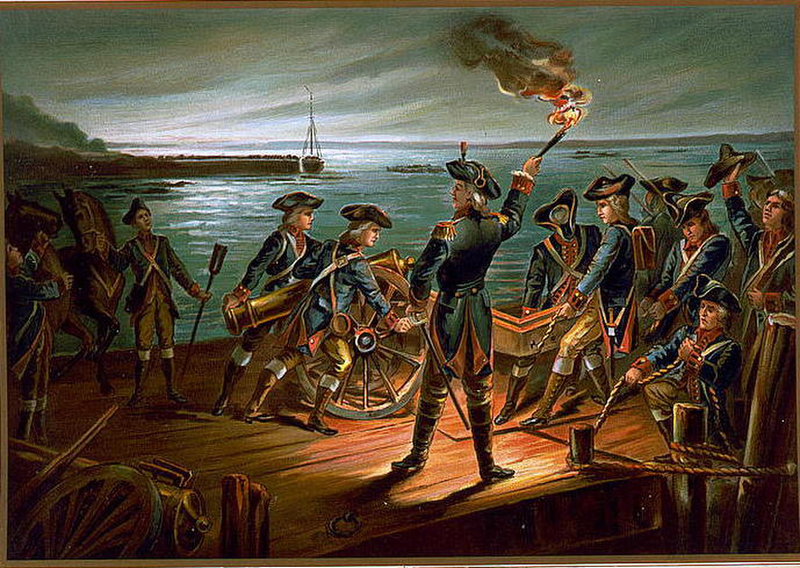If 1776 was the year America declared its independence, it was also the year it nearly lost it. By December, the Continental Army was in shambles, George Washington was on the run, and the British were poised to deliver the final blow. But just when all hope seemed lost, two men—Washington and Thomas Paine—stepped up to turn the tide. This is the story of how a retreating army and a fiery pamphlet saved the American Revolution.

The Darkest Hour: Washington’s Retreat Through New Jersey
After the fall of Fort Washington in November 1776, Washington’s army was in full retreat. With only 3,000 ragged, starving soldiers left, he crossed the Delaware River into Pennsylvania, leaving New Jersey to the British. The situation was dire. The Continental Army was outnumbered, outgunned, and out of options. To make matters worse, enlistments were set to expire at the end of the year, and morale was at an all-time low. As one soldier put it, the army was “barefoot, poorly clothed, and worse fed.”
The British, under General William Howe, seemed unstoppable. They had taken New York, chased Washington across New Jersey, and were now preparing to winter in comfort while the Americans starved. Howe even issued a proclamation offering pardons to any colonist who pledged loyalty to the Crown. Thousands took the offer, and it seemed like the revolution was on its last legs.
The Plot Thickens: Charles Lee’s Capture
Just when things couldn’t get worse, they did. In December, General Charles Lee—Washington’s second-in-command and a man many believed should be leading the army—was captured by the British. Lee had been dragging his feet, ignoring Washington’s orders to join him in Pennsylvania. Some speculated that Lee was hoping Washington would fail so he could take over as commander. Instead, Lee found himself a prisoner of the British, and Washington was left to face the crisis alone.
Thomas Paine’s American Crisis: A Rallying Cry
As Washington struggled to hold his army together, Thomas Paine—the author of the revolutionary pamphlet Common Sense—stepped up to inspire the troops. Paine had joined the Continental Army as an aide to General Nathanael Greene and witnessed the army’s suffering firsthand. In December, he penned The American Crisis, a series of essays designed to rally the troops and the nation.
The opening lines of The American Crisis are some of the most famous in American history:
“These are the times that try men’s souls. The summer soldier and the sunshine patriot will, in this crisis, shrink from the service of their country; but he that stands by it now, deserves the love and thanks of man and woman.”
Paine’s words struck a chord. Washington had the essay read aloud to his troops, and its message of resilience and determination helped restore morale. Paine reminded the soldiers that their cause was just, their struggle noble, and their victory possible—if they had the courage to fight on.
Washington’s Gamble: The Crossing of the Delaware
With Paine’s words ringing in their ears, Washington knew he needed a bold move to turn the tide. He decided to strike back at the British—not with a grand battle, but with a surprise attack. On Christmas night, 1776, Washington led his army across the icy Delaware River, targeting a garrison of Hessian mercenaries stationed in Trenton, New Jersey.
The crossing was treacherous. The river was choked with ice, and a winter storm raged as the men struggled to ferry themselves, their horses, and their cannons to the other side. But Washington’s determination paid off. By dawn on December 26, his army had reached Trenton and launched a surprise attack. The Hessians, caught off guard and still recovering from their Christmas celebrations, were quickly overwhelmed. The Americans captured nearly 1,000 prisoners and seized much-needed supplies.
The victory at Trenton was a turning point. It proved that the Continental Army could fight—and win—against the British. More importantly, it restored hope to a revolution that had been on the brink of collapse.
The Aftermath: A New Hope
Washington followed up his victory at Trenton with another successful attack at Princeton in early January 1777. These victories not only boosted morale but also convinced many soldiers to reenlist. The Continental Army, which had been on the verge of disintegration, was now a fighting force once again.
The British, meanwhile, were forced to rethink their strategy. Howe had assumed the revolution would fizzle out on its own, but Washington’s daring attacks showed that the Americans were far from defeated. The war would drag on for another six years, but the tide had begun to turn.
The Legacy of 1776: Resilience in the Face of Adversity
The winter of 1776 was a defining moment in American history. It tested the resolve of the Continental Army, the leadership of George Washington, and the spirit of the American people. Through it all, two men—Washington and Paine—emerged as symbols of resilience and determination.
Washington’s leadership during this crisis cemented his reputation as the “Father of His Country.” His ability to inspire his men, make tough decisions, and adapt to changing circumstances would prove crucial in the years to come. Paine, meanwhile, became the voice of the revolution, using his pen to rally the troops and the nation.
Conclusion: Lessons for Today
The story of 1776 is more than just a historical footnote—it’s a reminder of the power of perseverance. Washington and Paine showed that even in the darkest times, hope and determination can lead to victory. Their legacy lives on in the American spirit, a spirit that continues to inspire people around the world.
So, the next time you’re facing a tough situation, remember Washington crossing the Delaware and Paine’s stirring words. If they could turn the tide of a revolution, surely you can overcome whatever challenges come your way. After all, these are the times that try men’s souls—but they’re also the times that make heroes.

No comments yet.